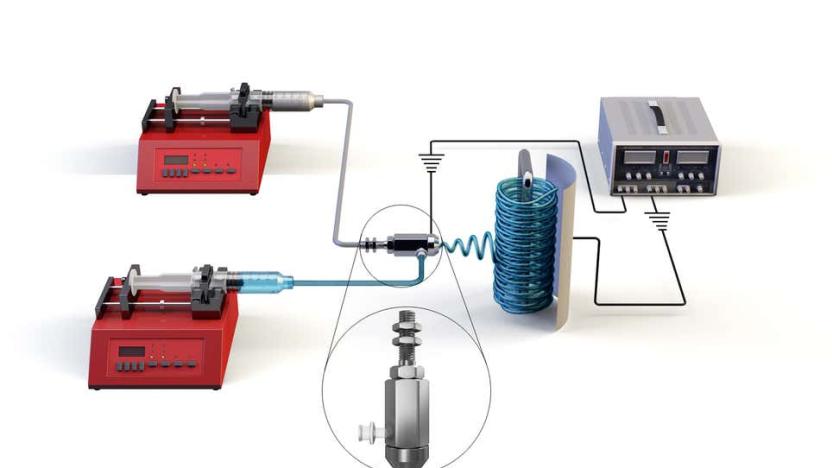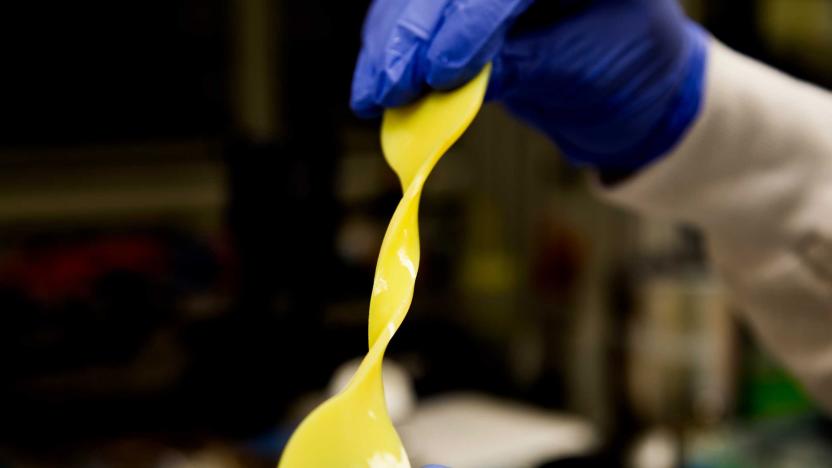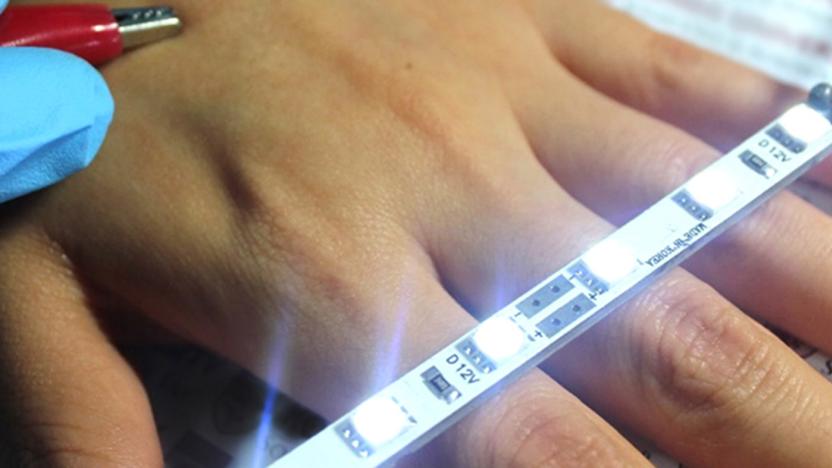nanofiber
Latest

3D-printed 'living ink' could lead to self-repairing buildings
Scientists have developed a 'living ink' that could be used to print organic materials, possibly including buildings that repair themselves.

A nanofiber membrane could help solve the drinking water crisis
Researchers from the Korea Institute of Civil Engineering and Building Technology have created a nanofiber membrane that can desalinate water for up to a month.

Kevlar cartilage could help you recover from joint injuries
It can be difficult to fully recover from knee injuries or other damage to your joints, if just because there hasn't been an artificial replacement for cartilage that can withstand as much punishment as the real thing. That may not be an issue in the long run, though: scientists have developed a Kevlar-based hydrogel that behaves like natural cartilage. It mixes a network of Kevlar nanofibers with polyvinyl alcohol to absorb water at rest (like real cartilage does in idle moments) and become extremely resistant to abuse, but releases it under stress -- say, a workout at the gym.

Nanofiber film could lead to electronic skin
If you want electronic skin or other transparent wearable devices, you need to send a current through that skin. However, it's hard to make something that's both conductive and transparent -- and that's where a team of American and Korean researchers might save they day. They've developed a nanofiber film that's 92 percent transparent, but has electrical resistance that's "at least" 10 times better than the previous best. You create it by electrospinning polyacrylonitrile (a polymer resin) until it forms a mat, spatter-coat it with metal and then electroplate it. The result is a material that eases the flow of current but is mostly made up of see-through holes.

Nanofiber gel and snake venom work together to stop the bleeding
Researchers at Rice University announced a novel use for batroxobin, a hemotoxic component in the venom of two South American pit viper species. They've figured out how to leverage it as a potent coagulant -- when combined with a nanofiber hydrogel called SB50 -- that could save countless lives in surgery. Medical science has actually been employing batroxobin as a topical clotting agent and thrombosis treatment since the mid 1930s. Used along with the gel, now it's shown a capability to stop the flow of blood even if the patient is on heparin, a powerful anticoagulant administered before some surgeries.

Super-thin Kevlar layers promise safer, slimmer batteries
Scientists have spent a lot of time trying to lengthen battery life, but safety and thickness matter, too. Just ask Boeing about that first problem -- its 787 Dreamliner was grounded for months thanks to battery fires. However, a group of University of Michigan researchers may have found a way to make lithium-ion energy packs that are safer and slimmer at the same time. The team has developed Kevlar-based, nano-sized membranes that insulate the electrodes in a battery while still allowing lithium ions to pass through and create a proper circuit. The extra-thin layers should not only reduce the chances of short circuiting, but allow for more energy in a given space. You could get away with thinner batteries in smartwatches and other devices without giving up battery life... or worrying that your device will spontaneously combust, for that matter.

Japanese 'smart clothing' uses nanofibers to monitor your heart-rate (video)
Japanese mobile carrier NTT Docomo and materials developer Toray have been working on joint projects for a while and now they're publicly announcing one. Welcome Hitoe (Japanese for "one layer"), cloth that contains Toray's nanofibers that are coated in a transmittable layer. It's not the orange cloth (that's just standard material), but the nicotine-patch sized square you attach to it that does the sensing. Place two of these on you and they'll act as electrodes, measuring your heartbeat and even offering metrics resembling a cardiogram. The plan is to connect this cleanly non-invasive health monitor to NTT Docomo's health app platform that's already on its smartphones, developing practical... soft... hardware for sale alongside it. The pitch didn't just include sports clothing, however, with pajamas and other sleepwear planned for launch. Look! There's even a little hat! The sensors will apparently survive tumbles in the washing machine and, having seen an earlier prototype late last year, we can confirm that the patches are suitably lightweight and flexible -- now the work is down to reducing that lumpy hub sensor that we also spotted. Wearable gadgets might finally be going subtle. There's a quick video from our allies at Engadget Japanese after the break.

Fruity nanofibers could make for super-strong plastics, banana-flavored body panels
Carbon fiber is still the material of choice for high-end components that need lots of strength without a lot of weight, but wouldn't life be better if those components were made of pineapple? Apparently, yes. At least that's the case according to Brazilian scientists led by Alcides Leão, who have created so-called nanofibers from the pulp of various fruits, including pineapple leaves and coconut shells. These are processed down to create nano-scale threads that, when added to plastics, form a composite 30 percent lighter than carbon fiber yet three or four times stronger. Healthier, too. No word on when this stuff might be in full production, but we look forward to cradling our future fruit-based gadgets.

Nanofiber lighting promises to be better, safer than incandescent or CFL bulbs
Well, it looks like you can add another contender to the great light bulb debate -- a group of researchers from RTI International now says that nanofiber lighter is more efficient than incandescent light bulbs, and safer than compact fluorescents. The secret to that, it seems, is a combination of nanofiber-based reflectors and photoluminescent nanofibers (or PLN), which together are able to form a lighting device that pumps out more than 55 lumens of light output per electrical watt consumed. That's five times more efficient than a regular incandescent light bulb, and since there's no mercury, the researchers say it's far safer than CFL bulbs. What's more, it's also apparently able to produce more natural light than CFLs, although there's noticeably no mention of potential pricing -- they do say that the first products using nanofiber lighting could be available in three to five years, though. Video after the break. [Thanks, DeFlanko]

Flexible, stretchable, rubbery OLED prototype shown off in Tokyo
Electrical engineering researchers at the University of Tokyo have developed a flexible, stretchable OLED that acts something like rubber, and does not tear or break when stretched. The material is produced by spraying a layer of carbon nanotubes with a fluoro-rubber compound, creating a rubbery, conducive material. The current, monochrome display prototype has a resolution of just 256 pixels, is 10-centimeters square, and can apparently be folded about 1,000 times with out falling apart, tearing, or imploding. The team is presenting its findings in the British science journal Nature Materials this month.[Via Slashgear]

Fukitorimushi cleaning bot is just like a pet -- only cleaner, quieter, better behaved, and more pillow-shaped
Panasonic recently unveiled a new kind of cleaning robot at the Tokyo Fiber Senseware Expo in Milan. Called Fukitorimushi, the small service bot is covered in Nanofront, a nanofiber polyester fabric which can absorb oil and pick up small paricles of dust. It moves a bit like an earthworm, crawling about the floor using several light sensors to root out the dirt, and can navigate itself back to its charging station when it needs more juice. Designers of the spiffy little guy seem to think that owners will bond to it as if it were a pet. No word on when these dudes will be commercially available, but we'll let you know as soon as we score one of our very own -- we're thinking about calling it Sal. There's a video of it doing its rather unnerving business after the break.[Via Robots.net]





